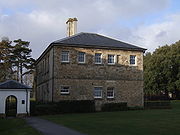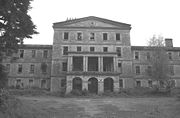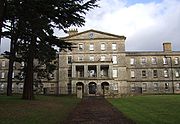
Oakwood Hospital
Encyclopedia

Barming
Barming is a civil parish in the Maidstone District of Kent, England. It lies to the west of Maidstone, the county town, and had a population of 2234 persons . The eastern end of the parish is part of the built-up area of Maidstone, although the remainder is much more rural...
Heath
Barming Heath
Barming Heath is an area of NW Maidstone in Kent, England. The parish church is dedicated to St Andrew....
near Maidstone
Maidstone
Maidstone is the county town of Kent, England, south-east of London. The River Medway runs through the centre of the town linking Maidstone to Rochester and the Thames Estuary. Historically, the river was a source and route for much of the town's trade. Maidstone was the centre of the agricultural...
, England
England
England is a country that is part of the United Kingdom. It shares land borders with Scotland to the north and Wales to the west; the Irish Sea is to the north west, the Celtic Sea to the south west, with the North Sea to the east and the English Channel to the south separating it from continental...
was a psychiatric hospital
Psychiatric hospital
Psychiatric hospitals, also known as mental hospitals, are hospitals specializing in the treatment of serious mental disorders. Psychiatric hospitals vary widely in their size and grading. Some hospitals may specialise only in short-term or outpatient therapy for low-risk patients...
founded in 1833 as the Kent County Lunatic Asylum to an Early Corridor design by the Surveyor to the County of Kent
Kent
Kent is a county in southeast England, and is one of the home counties. It borders East Sussex, Surrey and Greater London and has a defined boundary with Essex in the middle of the Thames Estuary. The ceremonial county boundaries of Kent include the shire county of Kent and the unitary borough of...
, John Whichcord Snr
John Whichcord Snr
John Whichcord Snr was a British architect who worked in Maidstone, Kent and designed many public and institutional buildings in the town.-Life:Whichcord, the son of a surveyor, was born in Devizes, Wiltshire...
. In the mid-nineteenth century, the superintendent of the asylum was Dr James Huxley (1821-1907), elder brother of Thomas Henry Huxley, the evolutionary biologist and friend of Charles Darwin
Charles Darwin
Charles Robert Darwin FRS was an English naturalist. He established that all species of life have descended over time from common ancestry, and proposed the scientific theory that this branching pattern of evolution resulted from a process that he called natural selection.He published his theory...
. Following transfer of services to Maidstone General Hospital
Maidstone Hospital
Maidstone Hospital is a hospital in Barming, Maidstone, England. It is managed by the Maidstone and Tunbridge Wells NHS Trust.-History:...
, Oakwood closed in 1994, and was then developed as a residential estate known as St Andrew's Park.
History
The Oakwood Hospital was originally founded as the "Kent County Lunatic Asylum". It was erected between 1829 and 1833 on a site in Barming HeathBarming Heath
Barming Heath is an area of NW Maidstone in Kent, England. The parish church is dedicated to St Andrew....
, just to the west of Maidstone
Maidstone
Maidstone is the county town of Kent, England, south-east of London. The River Medway runs through the centre of the town linking Maidstone to Rochester and the Thames Estuary. Historically, the river was a source and route for much of the town's trade. Maidstone was the centre of the agricultural...
. It comprised one building; commonly referred to as St Andrew's House,. The asylum was intended to take in patients from across the entire county of Kent, which then stretched as far west as Greenwich
Greenwich
Greenwich is a district of south London, England, located in the London Borough of Greenwich.Greenwich is best known for its maritime history and for giving its name to the Greenwich Meridian and Greenwich Mean Time...
. The first 168 patients were admitted in 1833. As the asylum expanded, additions and extensions were made to this building until it had reached maximum potential capacity. In 1850 an additional building, known as The Queen's House, was built on newly acquired land at the site. Both of these buildings were designed by the architect John Whichcord Snr
John Whichcord Snr
John Whichcord Snr was a British architect who worked in Maidstone, Kent and designed many public and institutional buildings in the town.-Life:Whichcord, the son of a surveyor, was born in Devizes, Wiltshire...
(who also designed Maidstone County Gaol
Maidstone (HM Prison)
HM Prison Maidstone is a Category C men's prison, located in Maidstone, Kent, England. The prison is operated by Her Majesty's Prison Service.-History:...
). Further expansion took place between 1867 and 1872 with the building of the third asylum block (also known as the New Building or Hermitage Block).
By 1948, Oakwood held 2,000 patients. On 29 November 1957, a fire broke out in the tailor's workshop on the first floor of one of the buildings. The fire brigade was called at 06:40 and arrived four minutes later. Six pumps attended and the 350 patients in that wing were evacuated. By 08:00 the fire was out, and the clearing-up process began. The block had been gutted but a 120 feet (36.6 m) tall ventilation tower seemed to have survived unscathed. At 10:00, the tower collapsed, killing four firemen, two nursing staff and a patient and injuring a number of people.
Closure
During the 1970s and 1980s there was a change in focusCare in the Community
Care in the Community is the British policy of deinstitutionalization, treating and caring for physically and mentally disabled people in their homes rather than in an institution...
on the best way to treat the mentally ill and housing patients long-term in large institutions was falling out of favour. It was therefore inevitable that the Oakwood Hospital would close or see a change in its role.
Plans for a new hospital for Maidstone were approved in the mid-1970s and the site chosen was just to the north of the Oakwood Hospital. Construction on the Maidstone Hospital began in 1980 and was completed in 1982/1983. The Oakwood Hospital then became known as the Maidstone Hospital (Psychiatric Wing) and some of its functions began to be transferred across to the new hospital.
The Maidstone Health Authority Operational Plan for 1984/85 (paragraph 4.2) states that the long term objective was to close the Oakwood Hospital. The publication of the Short Term Program for 1986-87/1987-88 (paragraph 6.7) recommends the closure of St Andrew's House which by that time had ten wards (nine for Medway Health authority patients and one for all user authorities) and 186 patients. The Program acknowledged that this closure would accelerate the strategic objective of vacating the total site.
Final closure of the Oakwood Hospital came in the 1990s when all its remaining functions had been transferred to the Maidstone Hospital. After closure there were a spate of arson attacks on the buildings and on 11 May 1997 work began to demolish the Hermitage Block and other unused buildings. St Andrew's House and The Queen's House are both Grade II listed buildings and so were spared demolition. The Queen's House was sold off in April 1997 and was soon then turned into residential use. St Andrew's House was converted into apartments in 2001-2002 after some £60,000 was spent by a specialist firm to landscape the grounds which had become overgrown. A new housing development now occupies the site of the demolished Hermitage Block.
St Andrew's House - life after closure
St Andrew's House was converted into apartments in 2001-2002. The exterior of the rear of the building has changed little since its construction it the 1830s. The small high windows were replaced by 12 pane replica sash windows following conversion for residential use. New communal bin stores have been built, the prominent octagonal chimney stack has been removed and to the rear of the building is the residents' car park.






